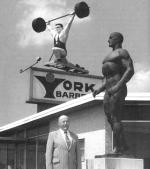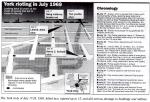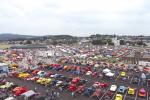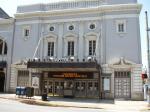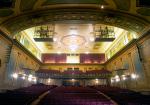![header=[Marker Text] body=[Laid out in 1741, by order of the Proprietors; the first Pennsylvania town west of the Susquehanna River. Seat of the Continental Congress, 1777-78; birthplace of the Articles of Confederation. ] sign](http://explorepahistory.com/kora/files/1/10/1-A-3DF-139-ExplorePAHistory-a0n2l3-a_450.jpg)
Mouse over for marker text
Name:
York
Region:
Hershey/Gettysburg/Dutch Country Region
County:
York
Marker Location:
U.S. 30, .1 mile E of York; U.S. 30, W of York; U.S. 111, N of York; U.S. 111 S of York
Dedication Date:
July 17, 1947
Behind the Marker
Advertised in the 1960s as "Historic York-First Capital of the U.S.A.," York is perhaps better known as "Muscletown, U.S.A." Until the 1960s, local promoters championed its mixed industry rather than its heritage. During World War II, its Manufacturers' Association devised the "York Plan," a fifteen-point program to organize and maximize the productivity of regional workers, machinery, and material that soon became a national model for increasing the efficiency of industrial production.
In 1945, its Chamber of Commerce proclaimed that York had Pennsylvania's lowest unemployment rate and greatest industrial diversity, for it made refrigeration machinery, safes, turbines, chains, artificial teeth, wallpaper, York Peppermint Patties, and pretzels. It had also attracted assembly and distribution plants because of its proximity to New York, Philadelphia, and Baltimore, and comparatively lower costs of operation. Continental Wire and Cable opened a plant in 1946, followed by Sylvania, Caterpillar Tractor, and Broker Manufacturing and Supply in the 1950s.
York's "Muscletown" image came from the York Barbell Company, which produced world-renowned barbells, trained the National Weightlifting Team, and sponsored a championship barbell team. Capitalizing on a post-war fitness craze, it sold fitness machines, books, and health products, including a "Hi-Proteen" dietary supplement marketed as a Cold War weapon. After American Machine and Foundry Company opened Harley-Davidson's largest assembly plant there in 1973, York also attracted motorcyclists who came for assembly-plant tours, open houses, and bike nights.
York Barbell Company, which produced world-renowned barbells, trained the National Weightlifting Team, and sponsored a championship barbell team. Capitalizing on a post-war fitness craze, it sold fitness machines, books, and health products, including a "Hi-Proteen" dietary supplement marketed as a Cold War weapon. After American Machine and Foundry Company opened Harley-Davidson's largest assembly plant there in 1973, York also attracted motorcyclists who came for assembly-plant tours, open houses, and bike nights.
With its many industrial jobs, York had also attracted southern black migrants as early as the 1920s. From 1931 until full integration in 1955, York assigned its black students to two exclusively black district-wide schools, but allowed parents to request reassignment to others. By the early 1960s, York's nascent civil-rights movement entered a more activist phase. In 1963, ten busloads of demonstrators traveled to the March on Washington for Jobs and Freedom and some 1,500 protested racial discrimination in Penn Park.
After Martin Luther King's assassination in 1968, long simmering racial tensions fueled more overt violence. That July, tension rose after police reportedly fired warning shots to disperse youths in Penn Park. In August, a white man shot at a number of blacks, whom he accused of attempting a store break-in. Soon afterwards, William Orr, the black man who disarmed him, was killed by shotgun fire from a passing car. The summer of 1969 brought more violence between gangs of white and black youths, and clashes with the police. The casualties included Henry Schaad, a white police officer riding in an armored truck, and Lillie Belle Allen, a black woman visiting her sister. To stem the rising violence, Governor Raymond Shafer imposed a curfew, and 200 National Guard members patrolled the streets with tanks, jeeps, and armored trucks.
Following the racial unrest, many whites avoided downtown. Hoping to revive its downtown center, the city offered homes for as low as one dollar in areas where Hurricane Agnes had brought floods in 1972. More broadly, a Historic Architectural Review Board oversaw exterior renovations in the downtown area, the Planning Board adopted a preservation plan, and the city, working with Historic York Inc., placed a large section of York on the National Register of Historic Places.
After restoration, the Strand and the Capitol theaters reopened in the early 1980s. Despite these efforts, all the major downtown department stores closed, including Bon-Ton's flagship store on West Market Street in 1980. In the 1980s, a Facade Easement Program encouraged the reuse of the many vacant downtown buildings, and slowly professional offices, specialty stores, and restaurants filled some of the gaps.
Deindustrialization brought further challenges. York lost 11 percent of its manufacturing jobs between 1970 and 2000, and suffered a major setback in the mid-1990s when Caterpillar Tractor closed its York plant and moved production to southern plants with lower wages. Nevertheless, manufacturing jobs still accounted for more of the region's workers than in other Pennsylvanian metropolitan areas. As manufacturing declined, retail and service sector jobs grew. The York Inter-State Fair expanded Memorial Hall in 1995 and added its Toyota Arena in 2003, now a centerpiece of the York Expo Center, which hosts events year round.
York Inter-State Fair expanded Memorial Hall in 1995 and added its Toyota Arena in 2003, now a centerpiece of the York Expo Center, which hosts events year round.
York's past, however, still haunted the city, exacerbating urban problems. In 1999, newspaper coverage on the thirtieth anniversary of the 1969 riots led authorities to reopen the investigations of the Schaad and Allen killings. A policeman at the time of the riots, York's mayor Charles Robertson was tried and acquitted in 2002, but two former white gang members and two black men were found guilty on second-degree murder charges. Periodic confrontations between white supremacists and anti-racist demonstrators during the trials aggravated racial tensions.
Meanwhile, York's Hispanic population grew rapidly, and accounted for 17 percent of the total by 2000, at which time African Americans represented 25 percent of the city's population and whites about 60 percent. Plans for a racist rally in April 2006 led to the formation of "Healing York" whose members, fearing renewed confrontations planned "unity events" at the Crispus Attucks Community Center and discouraged anti-racists from returning to York.
Confronted by prolonged economic and social challenges, York officials worked hard to revive the city. In addition to showcasing the city's Revolutionary War heritage, they in 2007 welcomed a new minor league baseball team, the York Revolution, at the Sovereign Bank Stadium. Houses and industrial buildings were renovated to provide apartments and office space. Building on the success of the Strand-Capitol Performing Arts Center, city planners were promoting a York Cultural District.
In 1945, its Chamber of Commerce proclaimed that York had Pennsylvania's lowest unemployment rate and greatest industrial diversity, for it made refrigeration machinery, safes, turbines, chains, artificial teeth, wallpaper, York Peppermint Patties, and pretzels. It had also attracted assembly and distribution plants because of its proximity to New York, Philadelphia, and Baltimore, and comparatively lower costs of operation. Continental Wire and Cable opened a plant in 1946, followed by Sylvania, Caterpillar Tractor, and Broker Manufacturing and Supply in the 1950s.
York's "Muscletown" image came from the
With its many industrial jobs, York had also attracted southern black migrants as early as the 1920s. From 1931 until full integration in 1955, York assigned its black students to two exclusively black district-wide schools, but allowed parents to request reassignment to others. By the early 1960s, York's nascent civil-rights movement entered a more activist phase. In 1963, ten busloads of demonstrators traveled to the March on Washington for Jobs and Freedom and some 1,500 protested racial discrimination in Penn Park.
After Martin Luther King's assassination in 1968, long simmering racial tensions fueled more overt violence. That July, tension rose after police reportedly fired warning shots to disperse youths in Penn Park. In August, a white man shot at a number of blacks, whom he accused of attempting a store break-in. Soon afterwards, William Orr, the black man who disarmed him, was killed by shotgun fire from a passing car. The summer of 1969 brought more violence between gangs of white and black youths, and clashes with the police. The casualties included Henry Schaad, a white police officer riding in an armored truck, and Lillie Belle Allen, a black woman visiting her sister. To stem the rising violence, Governor Raymond Shafer imposed a curfew, and 200 National Guard members patrolled the streets with tanks, jeeps, and armored trucks.
Following the racial unrest, many whites avoided downtown. Hoping to revive its downtown center, the city offered homes for as low as one dollar in areas where Hurricane Agnes had brought floods in 1972. More broadly, a Historic Architectural Review Board oversaw exterior renovations in the downtown area, the Planning Board adopted a preservation plan, and the city, working with Historic York Inc., placed a large section of York on the National Register of Historic Places.
After restoration, the Strand and the Capitol theaters reopened in the early 1980s. Despite these efforts, all the major downtown department stores closed, including Bon-Ton's flagship store on West Market Street in 1980. In the 1980s, a Facade Easement Program encouraged the reuse of the many vacant downtown buildings, and slowly professional offices, specialty stores, and restaurants filled some of the gaps.
Deindustrialization brought further challenges. York lost 11 percent of its manufacturing jobs between 1970 and 2000, and suffered a major setback in the mid-1990s when Caterpillar Tractor closed its York plant and moved production to southern plants with lower wages. Nevertheless, manufacturing jobs still accounted for more of the region's workers than in other Pennsylvanian metropolitan areas. As manufacturing declined, retail and service sector jobs grew. The
York's past, however, still haunted the city, exacerbating urban problems. In 1999, newspaper coverage on the thirtieth anniversary of the 1969 riots led authorities to reopen the investigations of the Schaad and Allen killings. A policeman at the time of the riots, York's mayor Charles Robertson was tried and acquitted in 2002, but two former white gang members and two black men were found guilty on second-degree murder charges. Periodic confrontations between white supremacists and anti-racist demonstrators during the trials aggravated racial tensions.
Meanwhile, York's Hispanic population grew rapidly, and accounted for 17 percent of the total by 2000, at which time African Americans represented 25 percent of the city's population and whites about 60 percent. Plans for a racist rally in April 2006 led to the formation of "Healing York" whose members, fearing renewed confrontations planned "unity events" at the Crispus Attucks Community Center and discouraged anti-racists from returning to York.
Confronted by prolonged economic and social challenges, York officials worked hard to revive the city. In addition to showcasing the city's Revolutionary War heritage, they in 2007 welcomed a new minor league baseball team, the York Revolution, at the Sovereign Bank Stadium. Houses and industrial buildings were renovated to provide apartments and office space. Building on the success of the Strand-Capitol Performing Arts Center, city planners were promoting a York Cultural District.




